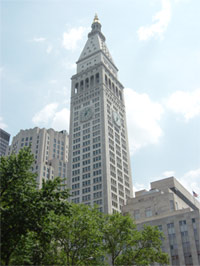Ice cooling buildings
On hot sunny days, electricity consumption in New York alone was equal to Chile. But with the ice cooling system that some buildings have deployed, this number can be reduced significantly.
The mechanism of this system is quite simple. At night, when the demand for electricity decreases, the system begins to cool ethylene glycol solution below freezing temperature. This solution will then be put into the pipe inside a reservoir to freeze the water. During the day, cool air from ice during melting will be pumped throughout the building, much like the cooling of traditional air conditioning systems. At night, the melted ice will be frozen again and the cycle will repeat.
Depending on conditions, one can only use this system alone or coordinate it with traditional air conditioning systems to reduce the load during peak hours. If used in the second way, every year, only the office of the Metropolitan Life office of Credit Suisse (one of the pioneers in installing ice-conditioning systems in New York) was also saved. 2.15 million kWh, equivalent to the annual demand of about 200 US households. This also means that the cost of building operations is significantly reduced.

Metropolitan Life Building in New York, USA, is using ice cooling system.(Photo: adrem.ua.ac.be)
That is not to mention the environmental benefits. Also in the case of the Metropolitan Life building, the use of an ice-conditioning system benefits the equivalent of stopping 223 cars or planting nearly 770,000 hectares of forest to absorb the CO2 that will arise. If using traditional air conditioning system. If you count New York City with thousands of large and small buildings, the numbers will be extremely impressive.
Defect
Besides the great benefits, the system requires a large space. To cool an office area with a total floor area of nearly 177,000 m2 as of Credit Suisse, one has to build 3 cold chambers with 64 tanks, each with a capacity of more than 3,000 liters. The cost to complete this system is $ 3 million, a figure that can discourage modest companies.
But for large companies and large, power-consuming buildings, this is clearly a beneficial solution. It is estimated that there are about 3,000 ice cooling systems in the world. Some corporations, such as Credit Suisse, have taken into account the installation of this system in all their buildings globally.
- The world's first self-cooling building
- Reflective paint can keep buildings cool in the sun
- Principle of operation of air coolers
- Good cooling water for children in the hot season
- Hot day cooling drinks are good for your health
- Basic cooling for hot days
- Cooling cabinets do not need electricity, do not need ice, can be folded neatly and still keep cold effectively
- Simple ways to cool your body in hot days
- The cooling system on ISS is broken
- Great way to cool cars 60 degrees after only 30 seconds
- Successfully developed cooling methods for magnetic refrigerators
- Video: Thermal cooling technology from heat
 Is the magnetic North Pole shift dangerous to humanity?
Is the magnetic North Pole shift dangerous to humanity? Washington legalizes the recycling of human bodies into fertilizer
Washington legalizes the recycling of human bodies into fertilizer Lightning stone - the mysterious guest
Lightning stone - the mysterious guest Stunned by the mysterious sunset, strange appearance
Stunned by the mysterious sunset, strange appearance Plan to build giant canopy over Antarctica has problems
Plan to build giant canopy over Antarctica has problems  Why does ice stick to your hands when you hold it?
Why does ice stick to your hands when you hold it?  NASA releases ice map on Mars
NASA releases ice map on Mars  After 389 days in the Arctic, costing more than $160 million, hundreds of scientists brought back bad news: What was it?
After 389 days in the Arctic, costing more than $160 million, hundreds of scientists brought back bad news: What was it?  650,000-year-old 'gateway to the underworld' discovered in Siberia
650,000-year-old 'gateway to the underworld' discovered in Siberia  How to explain the strange ice circle that rotates like a time-travel door?
How to explain the strange ice circle that rotates like a time-travel door? 